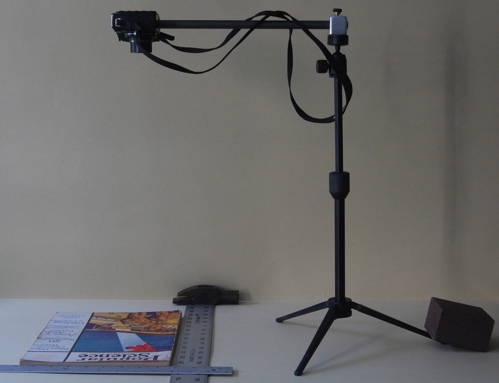Frequently, I need to examine books on-site. Often, the combination of low and mixed light sources made it difficult to get good enough digital images for notes. So I’ve built a lightweight boom that attaches to the Giottos QU-400 tabletop tripod. Although this boom cannot support a DSLR, there are some high end point and shoot cameras, such as the Nikon P6000 and Cannon G10, that have manual shooting modes and RAW capability. These cameras do not meet the recommended minimum standards of practice for documentation according to the AIC Guide to Digital Photography and Conservation Documentation, but they are very useful for visual note taking or emergency response. I am continually surprised by the difference in seeing when actually looking at an object, and when looking at a blown up digital image.

The tripod and boom weigh in at 1lb. 0.7 oz (472 grams) and collapse into a small bundle about 12 inches long. A weight or small clamp is necessary to keep the tripod from tipping. The shot below was around the equivalent of a 28 mm lens, which accounts for the distortion. Conservatively, the largest undistorted area is about 12 x 9 inches (30 x 23cm). It is also possible to position it off the edge of a table for a larger field of view, about 36 x 24 inches (92 x 61 cm).


The boom itself is pretty easy to construct and all the parts can be ordered from McMaster-Carr. A drill press, hacksaw and some aluminum files are the only tools required. I drilled and tapped tapped a 1″ block of 6061 T6 Aluminum 1/4-20 to mount on the head, and 10-32 for the brass thumbscrew. The 1/2″ boom rod is hard anodized Al, again tapped 1/4-20 to mount the camera and a small 6-32 set screw to hold the short threaded rod. The knurled portion of the thumbscrew was coated with a commercial rubber dip tool handle coating to provide more friction for easy tightening.
I experimented with a number of materials, and this combination, with the softest part being the brass screw, next the 6061 block and the hardest the rod. The end of the thumbscrew shows some distortion, but it is easy to replace. It seemed most important to maintain the concentric profile of the rod for smooth, even operation. After a couple of weeks of hard use, I can’t detect any deterioration.

A quick note about camera choice: The Canon PowerShot SX1 IS, which I think is the next step up in their line of point and shoot cameras has the “pop out” swiveling viewfinder. This is extremely helpful in many documentation scenarios, especially when dealing with set-ups like you’ve built.
Sometimes your just not tall enough to see down through the viewfinder when it is mounted like that. Having the swiveling viewfinder saves you from standing on chairs and crawling on counters to adjust your camera. I believe there are a few SLR models that offer this feature as well, which do meet AIC standards.
Makes sense to me. Thanks. I haven’t had too much trouble framing shots, although I usually err on the side of lots of white space around the book.